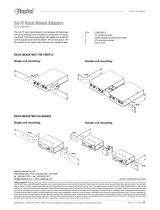
Q: Why is loading no longer a concern?
A: Back in the 1970’s, acoustic guitars did not have the sophisticated pickups and built-in pre-amps that are standard now.
Today, most electric basses incorporate high-output pickups or have active electronics built in. Acoustic guitar pre-amps
and keyboards can have equally high output levels. These high output levels are so powerful that loading is no longer the
concern. The ‘fix’ has in fact caused a new problem – input distortion or saturation.
Q: But I have heard that active DI’s are better?
A: Active DI’s can be good but they can have several disadvantages – active direct boxes require power. As such, they
must either run off batteries or 48V phantom power from the console. When power is low, they distort. This means that for
the direct box to work well, you must have fresh batteries. Furthermore, today’s high output instruments often overload the
direct box ‘input’ as it is unable to handle the dynamic range. This causes harsh square wave distortion that makes acoustic
guitars sound ‘edgy’ and bass and keys sound thin. Finally, most active direct boxes do not provide electrical isolation.
Transformers do this naturally and in doing so, eliminate hum and buzz caused by ground loops.
Q: What is phantom power and will it harm my JDI?
A: Phantom power is a DC supply that comes from the mixing console that was originally designed to provide power to
condenser microphones. It is typically 48 volts and about 5mA. When phantom is on, it will not harm the JDI.
Q: What is phase distortion?
A: Keeping your signal in phase is akin to making sure that when you play guitar, the sound coming from the low E-string
plays at the same time as the G-string as they come out of your amp. You may take this for granted but the fact is, phase
distortion can cause an instrument to get lost in the mix and make a bass sound muddy. Phase distortion can occur at
all frequencies but is most noticeable in the bass or low frequencies. Try facing your stereo speakers close together and
reverse the wires on one cabinet so that it is wired ‘out of phase’ and you will immediately become an ‘in-phase disciple’.
When we tested several popular direct boxes for phase deviation, we found that most were fine at 1000Hz. What surprised
us is how poorly the other DI’s performed at 20Hz. One popular direct box was 40º out of phase, while another was 20º
out! The Radial JDI tested at less than 4º. We spend thousands of dollars on PA systems to ensure they are time aligned
(in phase) while bad direct boxes vandalize the sound even before it gets to the mix position!
Q: What is the difference between phase and polarity?
A: This is often confused. Reversing the polarity means switching the (+) wire with the (-) wire in an electrical connection.
Reversing the phase has to do with the time domain. When a frequency is delayed by 180º and played with the original, the
out of phase signals cancel each other out. Reversing the polarity of one of two speakers has the same audible effect.
Radial Engineering JDI User Guide
13
True to the Music
























